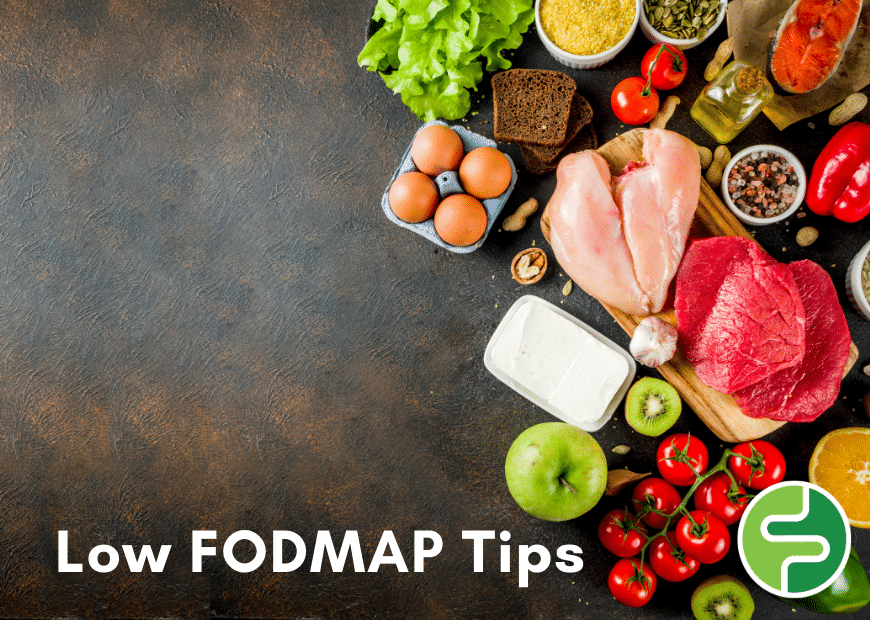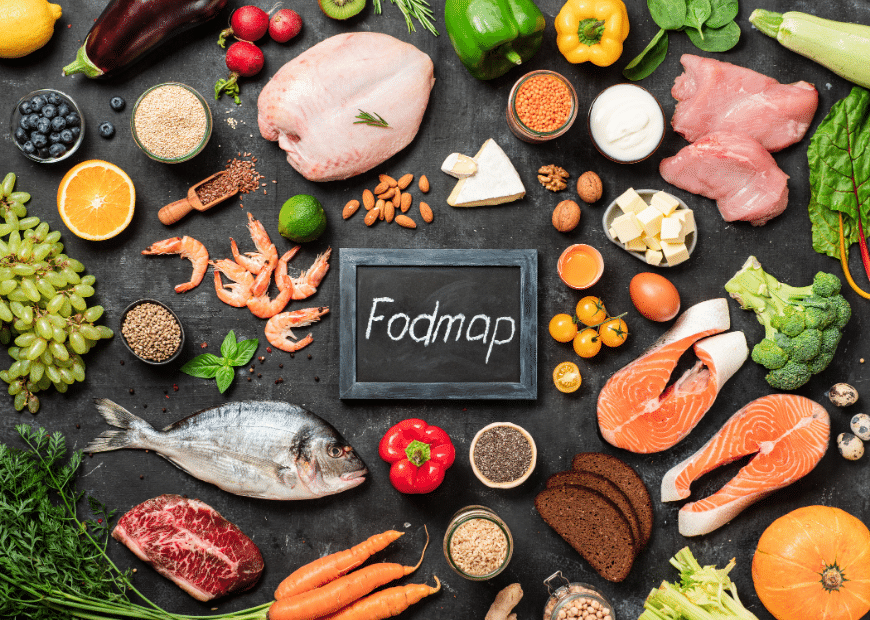The lowdown on the low FODMAP diet – five tips
Posted on February 10, 2021
What is the low FODMAP diet?
Traditionally, the low FODMAP diet is a three-phase process that involves the reduction or removal of foods high in FODMAPs. What are FODMAPs, you ask? Fermentable Oligosaccharides; Disaccharides; Monosaccharides and Polyols. These are the chemical names for several sugars that are poorly absorbed in the small intestine and can cause digestive discomfort.
The three phases of the low FODMAP diet involves the initial low FODMAP phase, challenge/reintroduction and long-term modification/individualisation. The overall goal of these steps is to identify which FODMAP groups are involved in triggering or exacerbating IBS symptoms, and subsequently use this information to develop a personalised approach that ensures as much variety and as little symptoms as possible.
There are many intricacies to the low FODMAP diet, but the team at FODMAP Friendly are here to give our five top tips specifically for newbies who have been medically diagnosed with IBS and are looking to embark on a low FODMAP diet. If this has not been done yet, we recommend seeing a doctor before enacting the tips below.
1. Build your support team
Done properly, the low FODMAP diet involves some ‘short term pain for long term pain relief’. Although the low FODMAP diet works to reduce physical discomfort, there can be a fair amount of ‘pain’ involved in wrapping your head around the diet and its many complexities. This is why building a strong, knowledgeable support team comes in at tip #1.
A FODMAP-trained Dietitian is a great person to have on your team. A Dietitian can perform a full patient assessment, including a symptom assessment and diet. They will be able to answer all of your FODMAP questions, and help you choose the best course of action when it comes to the way in which you’d like to implement the diet. When you try to embark on the low FODMAP diet yourself, it can be very easy to make mistakes and feel discouraged. A Dietitian will equip you with the knowledge and tools you need to succeed through the three phases and ensure that you are meeting all nutritional requirements as well. There is a higher risk of nutritional deficiencies when eating low FODMAP.
2. Clue Up
After seeking the guidance of a Dietitian, it is important that you also take the time to become ‘clued up’ to help make the transition from your regular diet to a low FODMAP diet a little smoother.
It is one thing to know what FODMAPs stand for, and another to know what they actually are. Have a look at reputable websites such as our FODMAP Friendly blog with multiple posts explaining the different letters that make up ‘FODMAPs’. Another great resource is the FODMAP Friendly App, which will help you discern the FODMAP content of foods.
FODMAP Friendly App for iOS & iPhones from the Apple Store
FODMAP Friendly App for Android from Google Play
Also, be sure to clue up by familiarising yourself with any FODMAP Friendly certified products at your local supermarket. You may want to set aside a few hours for your first shopping trip to spend time reading ingredients lists for high FODMAP-containing ingredients such as garlic or onion.
By knowing what FODMAPs are and which foods are low and high in FODMAPs, you will be better able to make a list of your favourite low FODMAP foods and plan your meals around that. The more you know, the easier the process will be!
3. Don’t forget the non-diet IBS symptom relief strategies
Following a low FODMAP diet is one (very important) piece of the IBS symptom relief puzzle, but it is not the only strategy to think about. While diet can often prevent or ease symptoms, stress is a major driver of symptom onset and severity. High stress can interfere with even the best dietary strategies.
When it comes to stress management, any behaviours you implement to manage your stress levels can help control your emotional response to IBS. You may like to consider taking up some gentle physical activity. Regular exercise can aid in stress reduction by stimulating the release of endorphins, leading to a greater sense of calm and well-being. Consider low impact exercise such as walking, yoga, light cycling, tai chi, or swimming – all activities which can help reduce stress and improve fitness. You can even type in ‘yoga for IBS’ on Google and retrieve a range of IBS-specific yoga flows! Meditation is another great stress management strategy to add to your toolkit, and again there are many wonderful free resources online to refer to when building this habit.
4. Watch out for other gut irritants
There are a few other unassuming and often hidden gut irritants that may make your IBS symptoms worse. Here are some foods/beverages to look out for:
Carbonated beverages: adding more air or bubbles to an already gassy and bloated digestive tract may result in more pain. Its best to limit sparking water, soft drinks, beer and sparkling wine for this reason.
Caffeine: caffeine intake should be monitored depending on the type of IBS you have. For those with IBS-D (diarrhoea), caffeine may exacerbate symptoms because it increases the stress hormone, cortisol, which increases gut motility and can lead to cramping and diarrhoea. For those with IBS-C (constipation), a little caffeine may help alleviate constipation.
Alcohol: also affects gut motility in various ways at different points of the digestive tract. Alcohol slows digestion, keeping food in your stomach longer which can increase ‘transit time’ and increase fermentation processes, producing gas and which may cause further discomfort. If you’d like to enjoy a drink over dinner, just ‘clue up’ on your low FODMAP choices. Some examples include a glass of red or white wine, gin, vodka and whisky. Make sure your choice of mixer is low FODMAP too!
High fat and Spicy Foods can also be but irritants so be mindful of these too.
5. Don’t skip the challenge phase of your low FODMAP diet!
You have completed the initial phase of the low FODMAP diet and have had symptom relief, how great! Then, your Dietitian asks you to begin your FODMAP challenges. Surely it would just be easier to stay on the low FODMAP diet forever, right? Not so fast! Following a low FODMAP diet is a diagnostic tool, not a forever diet. It is important to remember that the ‘initial low FODMAP’ phase is designed to set you up to complete the just-as-important challenge or re-introduction phase.
Some high FODMAP foods are highly nutritious foods that our gut bacteria love. In fact, many FODMAPs act like prebiotics and have a positive effect on our gut health. This means restricting FODMAPs long term could have a negative impact on your gut health and your overall health. For a combination of Prebiotics and Probiotics: The Gut Co FEED and REPAIR; Casa de Santé Advanced Probiotic & Prebiotics
By completing the challenge phase, you will ensure that you are not unnecessarily restricting FODMAPs that do not actually trigger your symptoms. A FODMAP-trained Dietitian can help you establish which exact foods trigger your symptoms. Through challenging your thresholds, you may be able to re-introduce some of these beneficial foods and plant diversity back into your diet.
In summary
There are a wealth of resources and support out there to guide you on the low FODMAP diet. Start by building your professional support team and working with a FODMAP-trained Dietitian. Make sure you’re ‘clued up’ to make your experience run as smoothly as possible. Consider adding some stress management strategies into your routine, while minimising other potential gut irritants along the way. Finally, be sure to complete the ‘challenge’ phase of your low FODMAP diet under the guidance of a Dietitian.
Written by Charlotte Barber (Student Nutritionist)
Reviewed by Kiarra Martindale (Accredited Practising Dietitian)













